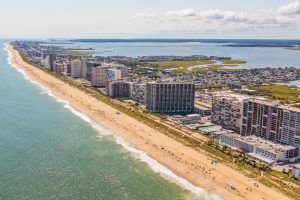
OCEAN CITY — What began as an overview on new federal flood insurance policies on Tuesday turned into a roast of sorts of Federal Emergency Management Agency (FEMA) representatives as an increasingly frustrated segment of resort property owners whacked with exorbitant premiums lashed out at an apparent flaw in the agency’s maps.
Last July, FEMA issued new flood insurance rate maps for the Town of Ocean City that recognized the value of the dune system constructed by the Army Corps of Engineers by locating the VE Flood Zone, or the most onerous flood insurance rate designation, “seaward of the landward toe of the primary frontal dune system.” In simpler terms, FEMA concluded the eastern edge of the long-established dune line should be the line of demarcation of sorts for the higher flood insurance rates and any properties west of the primary dune would fall into a lesser flood zone designation.
However, in a few areas of the resort, particularly along condo row from 93rd to 123rd streets, FEMA determined through its new maps an existing secondary dune, built in front of several oceanfront properties in the early 1980s is now the standard by which the VE Flood Zone is determined. As early as 1983, the town mandated certain new oceanfront projects construct a dune in front of the properties to protect them somewhat from storms, coastal flooding and beach erosion.
Years later, the primary dune was constructed through the beach replenishment project. As a result, the primary dune is out in front of the older secondary dune with a fenced alleyway of sorts about 10 feet wide in most cases separating the two. However, FEMA’s newest maps in many cases along condo row are now designating the seaward side of the secondary dune as the line marking the VE Flood Zone.
As a result, numerous oceanfront buildings now find themselves partially in the VE zone, some by as few as five feet. Because federal policy states if any portion of a building is located within the VE zone, the entire building is subject to the flood insurance requirements. For some individual property owners, the flood insurance rates in the VE zone run as high as $22,000 annually. For at least one oceanfront property used as an example, the flood insurance premium for the entire building approached half a million dollars.
On Tuesday, FEMA representative held a town meeting of sort at City Hall to brief residents, property owners, Realtors and insurance companies on the changes in the federal guidelines for flood insurance as they pertain to Ocean City. However, it didn’t take long for the discussion to get around to the issue of the apparent flaw in the maps that actually left areas with two separate dunes in the high risk areas while others with just the single dune were removed.
FEMA Risk Analysis Branch Chief Katie Lipiecki said the new maps actually removed roughly 60 percent of resort properties from the most onerous VE high risk zones, but urged all property owners to consider getting or maintaining flood insurance. She said there were affordable policies even for those who weren’t in the most onerous flood zone designations.
“In Ocean City, we saw a lot of structures come out of the high risk zone,” she said. “Even though they aren’t required to get it, it’s still available to them. Floods don’t recognize boundaries and if you live on a barrier island, it’s probably a good idea for you to get flood insurance.”
When town officials learned this spring many of the properties along condo row were inexplicably in the stringent VE zone, despite having two dunes for protection, they decided to file a formal Letter of Map Revision although the process has crept along at a snail’s pace. Lipiecki said federal guidelines dictate how the flood zone maps are drawn, but many oceanfront properties ended up in the VE zone despite having two dunes. She said FEMA is currently working through the issue with the town through the LOMR process.
“When we were mapping, we have regulations to follow,” she said. “We do take into account dunes and some secondary features that offer protection. We are working with the town to refine the data and really fill in the gaps where the dunes impact the boundaries.”
However, Delmarva Condominium Management Association President Joe Groves said it was inexplicable how the areas with the double dune system were included in the highest risk area and subject to exorbitant flood insurance premiums that must be paid until the issue is resolved.
“Common sense dictates if a dune protects property, than a double dune should offer even more protection,” he said. “That is not what has happened. Areas with double dunes actually went into the high risk areas.”
However, FEMA Floodplain Management and Insurance Branch Chief Nichole Lick said the maps don’t necessarily consider the two dunes as separate entities.
“We look at not a single dune or a double dune, but one dune system,” she said. “The town is trying to show areas with double dunes and we are working through that with them.”
City Engineer Terry McGean sat quietly in the back for the most part until he had heard enough of the bantering back and forth.
“We obviously have a disagreement,” he said. “It’s counter-intuitive when areas with double dunes are placed in the high risk zones while areas with single dunes are left out. We have to show that they can move the line and still offer the protection.”
McGean said the bureaucratic double-speak of sorts on the regulations regarding the areas with double dunes was a source of frustration for the town.
“It’s difficult and it’s frustrating,” he said. “We know that is not the case. The other 70 percent of the town with just the primary frontal dune is not in the high risk zone. Everybody in this room seems to understand this but FEMA.”
Some in the audience questioned why the property owners along condo row were not made aware of the map changes before getting whacked with exorbitant flood insurance premiums. Groves said there was ample opportunity to review the maps prior to them being published, but that didn’t soften the blow.
“A lot of condo owners and condo managers saw the maps, but when the final maps came out, those with double dunes found they are now in the VE zone. That’s why there is a lot of anger in this room,” he said.
Delegate Mary Beth Carozza asked the FEMA representatives at Tuesday’s meeting to take the message back to their supervisors with a sense of urgency.
“Obviously, there is an effort to show how to work through this double dune penalty,” she said. “We are working in good faith at the local level and ask you to take this back to FEMA and ask them to expedite this process.”
Lipiecki said FEMA higher-ups were already aware of Ocean City’s situation and the double dune conundrum and were working on the resort’s Letter of Map Revision request.
“It’s moving to the top of our list,” she said. “It’s becoming a very high priority.”
Nonetheless, Groves said many property owners and condo associations weren’t entirely happy with the pace of the request.
“We’re thankful that you’re here, but there is a lot of frustration in this room,” he said. “We’ve been told to submit the paperwork and you’ll get back to us in a year. You are public servants and we rely on you to act on our behalf.”

